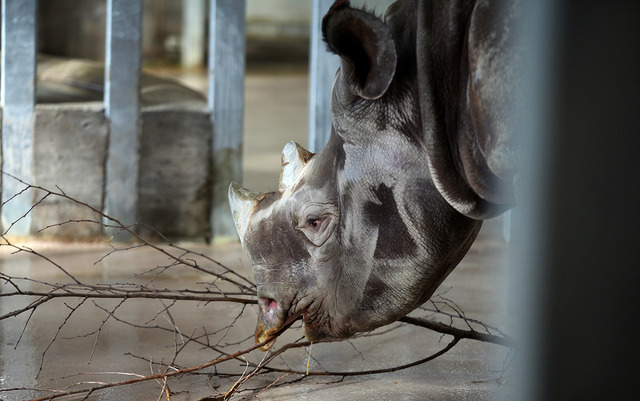Iowa zoo expecting rare baby eastern black rhino this fall

ASSOCIATED PRESS
File-In this Feb. 12, 2013, file photo, Ayana, a female black rhinoceros, snacks on twigs from her cage at the Blank Park Zoo in Des Moines, Iowa. Ayana and Kiano, eastern black rhinos at Blank Park Zoo in Des Moines, are expecting a baby in late October or early November. Ayana’s pregnancy is the first confirmed among the eastern black rhino zoo population in almost two years, experts say, marking a major turning point in the species’ decades long decline.
DES MOINES, Iowa >> A zoo in Iowa is expecting a new and rare addition in the fall: an eastern black rhinoceros.
Ayana and Kiano, eastern black rhinos at Blank Park Zoo in Des Moines, are expecting a baby in late October or early November, the Des Moines Register reported. Ayana’s pregnancy is the first confirmed among the eastern black rhino zoo population in almost two years, experts say, marking a major turning point in the species’ decadeslong decline.
Listed as critically endangered by the World Wildlife Fund, Des Moines’ rhinos are two of just 46 eastern black rhinos in North American zoos, according to leading zoological nonprofit organization Association of Zoos & Aquariums. Only six of those 46 rhinos are breeding females.
“This is fantastic for us and for the rhino population,” said Robyn Scanlon, a large animal zookeeper who has been working with Ayana and Kiano for three years.
In the wild, rhinos “are poached very, very frequently,” Scanlon said. “Their numbers have declined quite drastically over the past century, so having our own baby and being able to contribute to that population is awesome.”
Ayana and Kiano moved into Blank Park’s $4 million African exhibition in 2012. Both were born in captivity — Ayana at a Miami zoo and Kiano at the Great Plains Zoo in Sioux Falls, South Dakota — and began breeding in July.
Don't miss out on what's happening!
Stay in touch with breaking news, as it happens, conveniently in your email inbox. It's FREE!
Zoo officials are not sure when the baby will be on display.
“Because the species is so endangered, we want to make sure it is healthy and everything is OK before we put it on exhibit,” Scanlon said.




